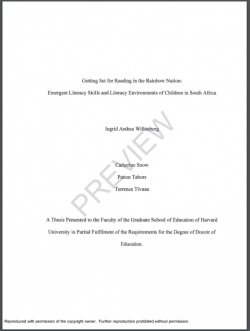The relationship between brain dominance, body laterality and literacy skills in grade 2 learners in a school in KZN

Type
Thesis
Authors
Category
ECCE, Foundation
[ Browse Items ]
Publication Year
2013
Publisher
North West University, Potchefstroom, South Africa
URL
[ private ]
Pages
197 p.
Subject
Early childhood development, Early childhood education, Primary education, Foundation Phase, Learners, Grade 2, Literacy, Reading, Spelling, Brain dominance, Phonological awareness, Barriers to learning, South Africa
Tags
Abstract
There is no doubt that basic literacy is vital to modern education. Although the majority of the population can read, many children, teenagers and adults seriously struggle with mastering reading skills. Most learners learn to read without great difficulty when they enter school. However, each year a portion of children experience significant problems learning to read. Educators in South African public schools are concerned that many learners are not learning to read and spell adequately. Multiple research conducted in South African schools indicate that a large number of children within the Foundation Phase experience problems with reading and spelling. Brain research suggests that for most people, the language centre of the brain resides in the left hemisphere of the brain. From this, it can be theorised that left-brain dominant learners would learn literacy skills, such as phonological awareness, spelling and reading, with greater ease. Other researchers have theorised that a correspondence between brain, eye, ear and hand dominance favours effective learning. The brain cannot learn without the sensory intake from the eyes, ears and hands. It is hypothesised that, since the brain works with a cross-over pattern, the dominant eye, ear and hand should be on the opposite side of the dominant brain. The desire was to dig deeper into this topic to find out if brain dominance, the correspondence between body and brain dominance, and mixed dominance do affect literacy learning as brain researchers suggest these dominances do. That is where the idea of this study was born. I investigated a number of relationships, namely the relationship between literacy skills and phonological awareness, between literacy skills and brain dominance, between literacy skills and eye dominance, between literacy skills and hand dominance, between literacy skills and ear dominance, the relationship between reading and spelling skills and finally which body dominance profile correlates with high literacy skills. Data were collected from 119 Gr 2 South African middle-class learners of mixed nationality and both genders. This data related to brain-, hand-, eye- and ear- dominance, and literacy skills such as reading, spelling and phonological awareness. Each participant was individually assessed to determine the dominant eye, ear and hand. Participants also completed the Neethling young child indicator brain profile to determine the dominant side of the brain, as well as the standardised ESSI reading and spelling tests and a phonological awareness test, which uses both real words and non-words. In this study, I found that phonological awareness is a good indicator of reading and spelling skills and that reading and spelling skills are related. Left brain, right eye, and left ear dominance were found to be associated with a statistically significant literacy skill advantage, whereas no significant support was found for an association between hand dominance and literacy skill advantage. These findings are important because they provide some answers to questions concerning the relationships between the various components of literacy (phonological awareness, reading and spelling), and between various dominances (brain, eye, ear and hand dominance) and literacy skill. They also provide possible causes of learning challenges, which may be addressed and overcome.
Number of Copies
1
| Library | Accession No | Call No | Copy No | Edition | Location | Availability |
|---|---|---|---|---|---|---|
| 1 | Potchefstroom, North West Province, South Africa | Yes |

